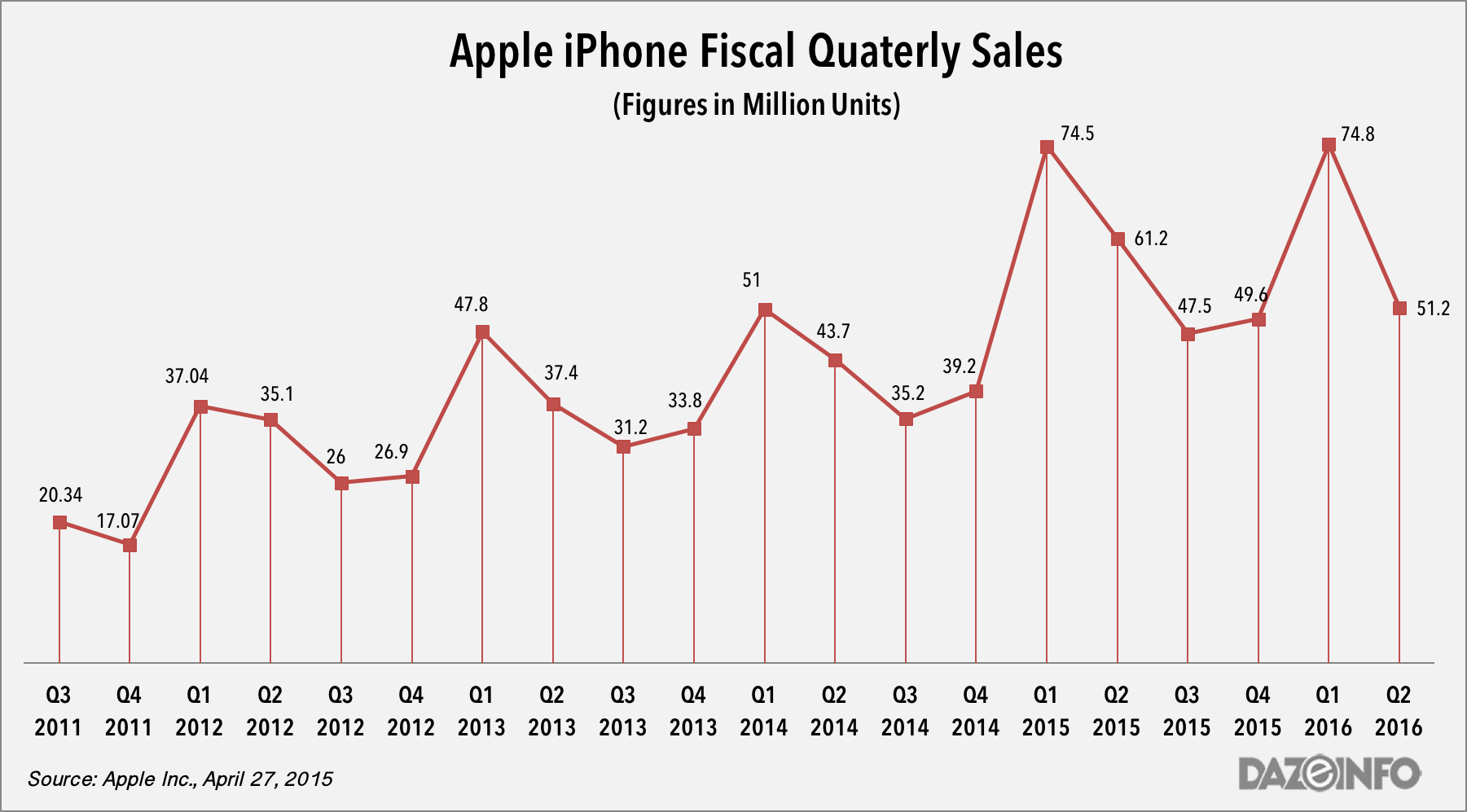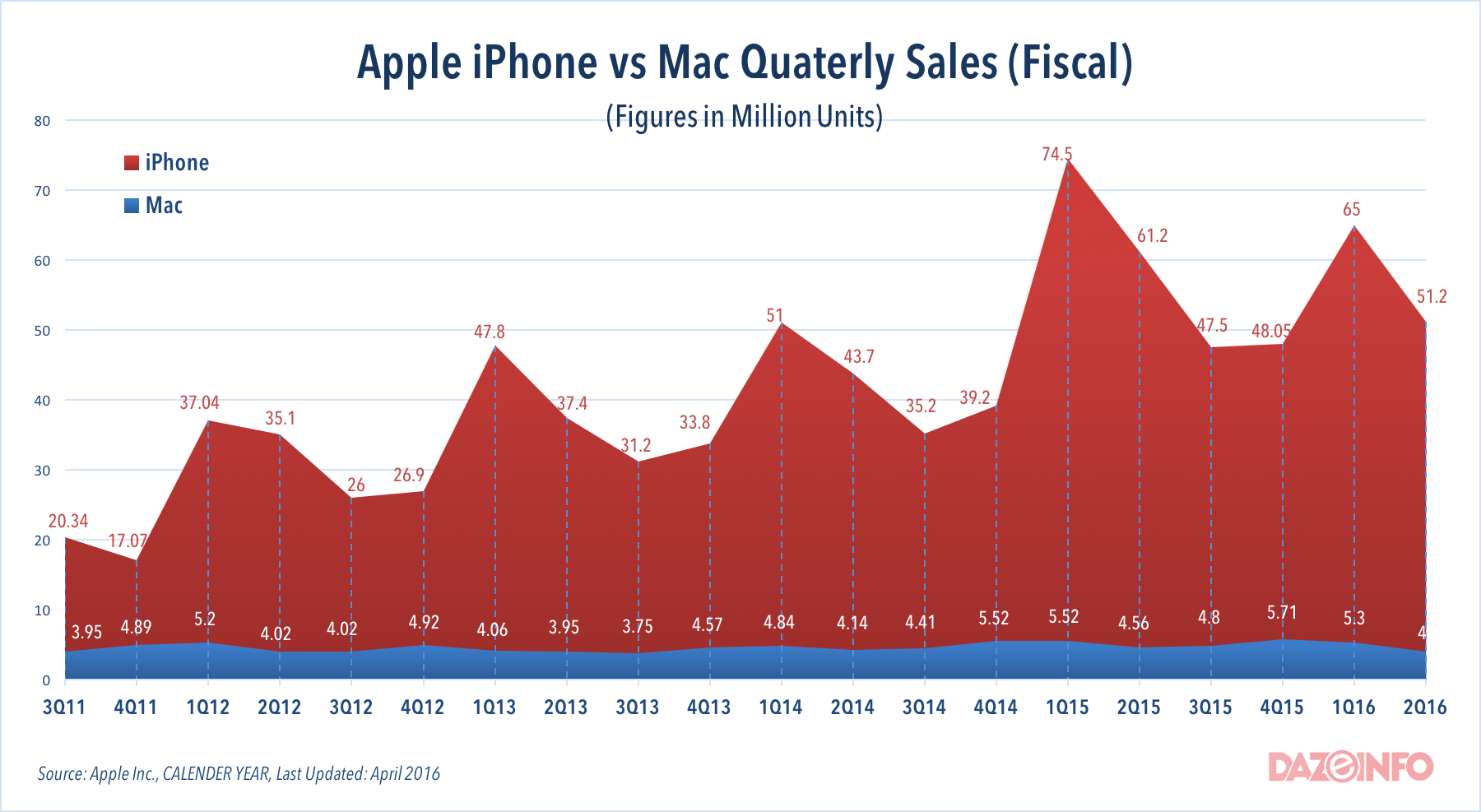The year 2016 is not bearing fruits for tech giants in Silicone Valley, and after Google and Microsoft, it was Apple’s turn to fall short of investor’s expectations as they took to the stage on April 26th to discuss their fiscal Q2 2016 results, or call it the Calendar Q1 2016. And it was a sombre affair as, for the first time in 13 years, Apple Inc. (NASDAQ:AAPL) had recorded negative growth on a YoY basis. While Apple CEO Tim Cook has managed to brush it away as a mere case of macroeconomic headwinds affecting sales figures, there is much more behind this slowdown than just the global economy and fluctuating dollar prices in key regions.
In recent years, with falling iPad and Mac sales, Apple has been reduced to a one-trick pony, it’s fortunes resting entirely on the sale of its flagship product- iPhones. So it comes as no surprise that with the dip in sales that had been forecasted ever since the lukewarm reception of the iPhone 6s and 6s Plus, the profit margins for the company had plummeted 22.8% YoY from $13.6 billion in Q2 2015 to $10.5 billion in Q2 2016. What, however, does indeed come as a shock is that Apple, the company that has traditionally always overshot analysts’ expectations, this time, underperformed a fair bit when it comes to revenue. What is even more worrying is that iPhone sales have made up about 65% of the revenue in this quarter compared to 69% a year back and it’s hovering around little over than 50% for the previous two years. It’s clearly evident that the company’s dependency on increasing on the product whose sales is slumping. So does that make Apple the tech world’s Titanic? We investigate!
The Saga of iPhones: Dwindling Profits And Tepid Customer Interests
While the numbers side of things has been expertly dealt with by my colleague in our comprehensive overview of Apple’s Q2 2016 earning report, today our take on the matter will come from a slightly different perspective. But before we begin, let me preface this by pointing out one important fact, the latest generation of iPhones 6s and 6s Plus are by no means bad phones, it just so happens that in the face of tough competition, they’re just not good enough. This will continue to be a recurring theme throughout the rest of this article, especially when it comes down to the management of the Cupertino giant.
A quick look at the graph reveals a rather sorry tale of 51.2 million iPhones sold in Q2 2016. While a QoQ comparison with Q1 2016 would be unfair, considering that it included the holiday season as well as Apple’s best quarter ever, it is vitally important as the mammoth drop of 23.6 million devices on a QoQ basis helps highlight a crucial fact. Once the initial excitement of the newly launched iPhones in September wore off, consumer interest became tepid at best. This is very important, especially in the context that on a YoY comparison with Q2 2015, there was a drop in sales by 16.2% or 10 million units.
So where did the 6s and 6s Plus go wrong? More than just one single factor, it was a multitude of reasons, some external, others internal that led to this slide to the bottom. Below we highlight just a few of them:
Over Dependability on Certain Markets
At 67%, more than half of Apple’s revenue comes from the foreign soil. As the smartphone market in the US has reached nearly 90% penetration, the growth has slowed down tremendously. With the market nearing saturation, Apple has moved to distant shores and in recent years has found incredible success in China. But that glorious ride came to a screeching halt this quarter, and we have outlined a few major reasons for the sudden fall of Apple in the Chine soil.
- The Chinese economy as a whole is going through an economic turmoil and with fluctuating dollar prices, the already expensive iPhone has suddenly gotten out of reach for many prospective buyers in what Apple calls the greater China region.
- But that in itself is not possible for the 26% YoY revenue drop that we have witnessed in China. Another major contributing factor is the rise of incredible products from Chinese OEMs like the Xiaomi Mi5 and the Huawei Nexus 6p that have managed to beat the iPhone not only with their below $500 price point but raw performance metric as well.
An Outdated Pricing Strategy
Apple iPhones are expensive, undeniably so. In fact, with just 20% of the global smartphone sales, Apple still manages to capture 90% of the profits of the smartphone world. This ability to sell overpriced smartphones has been based on three main pillars. The incredible brand value of Apple products, the carrier subsidy model in the US and to some extent the EU and lastly, the image of being a status symbol in the East. While we see how Apple’s grip on the Chinese market is toppling, the situation looks quite grim even in their homeland.
- With the availability of some incredible phones at the $400 price point, without any a carrier subsidy, the $700+ iPhone doesn’t make much sense for the average consumer.
- And with the increased saturation of the US market, the cellular carriers no longer feel the need to lure in customers with heavy subsidies on contractualised devices. With carriers looking to sell more devices up front and at the cost to their customer, the upgrade cycle becomes a carefully thought decision rather than just an eventuality of getting a new contract. This puts the price of the newer iPhone in context with other devices, and we see a lot more people holding onto their older devices or switching to less pricey alternatives.
Loosing Sight of Consumer Demands
Ever since the time of Steve Jobs, Apple has been a company that has always prioritised customer experience. Even though more restricted and often less powerful that it’s competition, Apple has managed to outshine Android in ease of use and simplicity. In fact, one of the major reasons that Apple was able to pull off a miracle and sell a gigantic number of iPhones both in the US and China, is primarily due to the fact that the introduction of the Plus sized iPhone was in direct response to their audience who wanted a bigger phone.
With the iPhone 6s though, Apple didn’t pay any heed to consumer demands and priced it exorbitantly in many countries across the world. This has alienated a major portion of their fan base, and yet it seems that they’ve not learned their lesson as the iPhone SE seems to be making the same mistake yet again.
Tim Cook: Traversing a Fine Line Between Genius and Insanity
If the above wall of text could be abbreviated into one single actionable sentence, it would probably be that Apple needs a leader with more insight into the mobile space, someone with a disruptive plan for the future. Even though Apple would like to remain in their own bubble, and blame their misfortunes on economic doldrums, the fact is that the smartphone market has flattened out. And despite its exalted position, this plateau has affected Apple as well, evidenced by their falling ASP of iPhones by a margin of $50 to $642.
Apple as it rose to its position as the most highly evaluated tech company in the world, found three main growth inducers. The iPod and the Mac, have both seen their heydays and are now in freefall and it looks as if the iPhone might be ready to join their ranks in a few years time. There is only a finite amount of time that Apple can hold onto the position of the highest evaluated company until their massive cash reserves start taking a hit. Following the legacy of Jobs, Tim Cook has introduced only two new products and while Apple Services and Apple watches has shown incredible growth to the tune of 20 and 30% respectively, the growth spur isn’t nearly enough to counteract the falling sales of iPads and Macs.
There is no great genius without some touch of madness- famous words spoken by Aristotle.
Below we take a look at few of Tim Cook’s decisions that certainly do seem to hint towards the latter part of the statement.
- The Capital Return Program: While the capital return program has been lauded by shareholders, a more focused investigation on the strategy reveals that the CEO has just run out of ideas and instead of spending the money on innovating new avenues of development, like the Autonomous Car, Tim Cook decided to play it safe and increase valuation of the company in the short term by introducing this program.
- The Pricing Strategy of the iPhone SE: The smaller form factor 4 inch iPhone was Apple’s answer to the budget offerings and their attempt at trying to stake a claim in the rapidly growing Indian market. However, the pricing strategy seems to have gone horribly wrong yet again with the seemingly ‘budget iPhone’ costing just as much as the flagships from Samsung and other Android OEMs.
- Getting the Primary Growth Strategy Totally Wrong: In an almost hilarious turn of events, when the already overpriced iPhone SE didn’t do well in India, Apple decided to jack the prices of their older models higher in a bid to introduce more sales of the device. If this is the way that Apple looks to target the Indian audience where despite the huge number of potential buyers the ASP of phones remains as low as 120$, then Apple’s dream of making India the new China will remain just that.
- Delaying New Products and Stifling Innovation: While the recent reports of the iPhone 8 provide the promise of a game-changing device, the wait till 2017 might draw away many potential customers. And while the Apple services division may be doing quite well, there are a number of stronger and better-equipped players in the field that have already spread their dominance. As for the new devices such as the Apple Watch, Android Wear seems to be hot on their heels as Apple looks to be struggling to retain market share.
All things considered, Tim Cook seems to have been lost control over the behemoth that is Apple and the lack of innovation is clearly showing, from Macs being overtaken in their own niche to Apple themselves issuing statements that seem more aimed at threatening people to upgrade rather than giving them a valid reason for it. The new online upgrade program seems to make little sense to even one who’s familiar with basic math and their headway into the Indian market seems to have been limited to setting up a few brand stores and trying to sell off recycled iPhones.
“The difference between stupidity and genius is that genius has its limits” said Albert Einstein.
Which way does Tim Cook sway? That is for you, the investors and time to decide! As for now, Apple’s predictions of another slow quarter of $41 billion to $43 billion, falls short of Wall Street’s expectations of $47 billion. Being caught in a global smartphone slump where even budget players like Xiaomi and Lenovo are finding it hard to hold onto their positions, Apple is faced with a rather precarious position. With their strategy of high margins coming under scrutiny, Apple has been pressed into action to use its giant cash reserves to innovate in some other in order to hold onto its crown. Whether Tim Cook is the man to lead Apple to salvation is the question that we leave our readers with.




